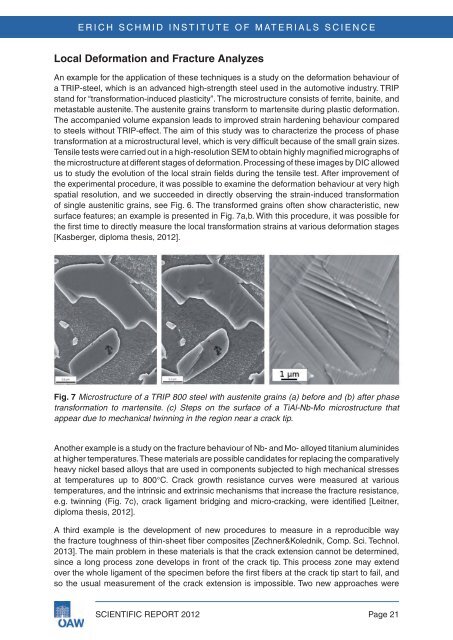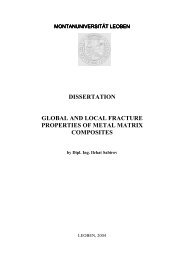Scientific Advisory Board - Erich Schmid Institute
Scientific Advisory Board - Erich Schmid Institute
Scientific Advisory Board - Erich Schmid Institute
You also want an ePaper? Increase the reach of your titles
YUMPU automatically turns print PDFs into web optimized ePapers that Google loves.
ERICH SCHMID INSTITUTE OF MATERIALS SCIENCE<br />
Local Deformation and Fracture Analyzes<br />
An example for the application of these techniques is a study on the deformation behaviour of<br />
a tRip-steel, which is an advanced high-strength steel used in the automotive industry. tRip<br />
stand for “transformation-induced plasticity”. the microstructure consists of ferrite, bainite, and<br />
metastable austenite. the austenite grains transform to martensite during plastic deformation.<br />
the accompanied volume expansion leads to improved strain hardening behaviour compared<br />
to steels without tRip-effect. the aim of this study was to characterize the process of phase<br />
transformation at a microstructural level, which is very difficult because of the small grain sizes.<br />
tensile tests were carried out in a high-resolution Sem to obtain highly magnified micrographs of<br />
the microstructure at different stages of deformation. processing of these images by dic allowed<br />
us to study the evolution of the local strain fields during the tensile test. After improvement of<br />
the experimental procedure, it was possible to examine the deformation behaviour at very high<br />
spatial resolution, and we succeeded in directly observing the strain-induced transformation<br />
of single austenitic grains, see fig. 6. the transformed grains often show characteristic, new<br />
surface features; an example is presented in fig. 7a,b. With this procedure, it was possible for<br />
the first time to directly measure the local transformation strains at various deformation stages<br />
[Kasberger, diploma thesis, 2012].<br />
Fig . 7 Microstructure of a TRIP 800 steel with austenite grains (a) before and (b) after phase<br />
transformation to martensite. (c) Steps on the surface of a TiAl-Nb-Mo microstructure that<br />
appear due to mechanical twinning in the region near a crack tip.<br />
Another example is a study on the fracture behaviour of nb- and mo- alloyed titanium aluminides<br />
at higher temperatures. these materials are possible candidates for replacing the comparatively<br />
heavy nickel based alloys that are used in components subjected to high mechanical stresses<br />
at temperatures up to 800°c. crack growth resistance curves were measured at various<br />
temperatures, and the intrinsic and extrinsic mechanisms that increase the fracture resistance,<br />
e.g. twinning (fig. 7c), crack ligament bridging and micro-cracking, were identified [Leitner,<br />
diploma thesis, 2012].<br />
A third example is the development of new procedures to measure in a reproducible way<br />
the fracture toughness of thin-sheet fiber composites [Zechner&Kolednik, comp. Sci. technol.<br />
2013]. the main problem in these materials is that the crack extension cannot be determined,<br />
since a long process zone develops in front of the crack tip. this process zone may extend<br />
over the whole ligament of the specimen before the first fibers at the crack tip start to fail, and<br />
so the usual measurement of the crack extension is impossible. two new approaches were<br />
<strong>Scientific</strong> RepoRt 2012 page 21

















